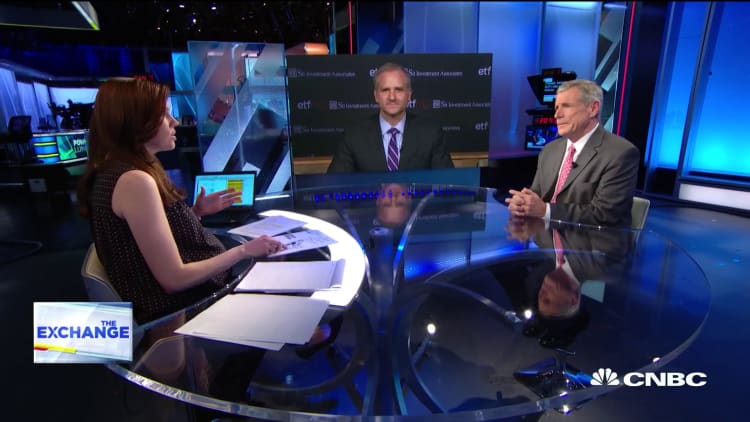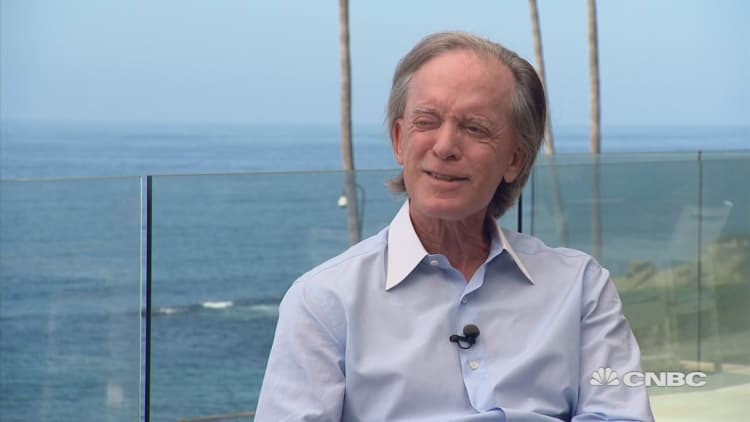Markets are braced for the Fed to cut rates by a quarter point next week, but some economists say a few of the reasons the Fed gave for making the cuts may be less pressing now.
Some see the Fed pausing after next Wednesday's cut. Goldman Sachs economists, in fact, expect the Fed to signal it will hold off after that one.
"They're in a very interesting period. It seems that the international risks they've been citing seem to be fading," said Drew Matus, chief market strategist at MetLife Investment Management.
He said trade war fears seem to have calmed down with talks between the U.S. and China progressing, but at the same time, the U.S. economic data has hit a soft spot with weakness in retail sales and September durable goods orders.

"It seems they shifted from nonquantifiable risks around the world, to more quantifiable risks at home," he said. "I think they believe that would warrant a cut."
Matus said he expects the Fed to cut rates, but he said odds it takes no action are probably about 30%. "It's not a foregone conclusion they cut at this meeting."
He said the Fed's so-called insurance cut, however, would be seen as supportive of the economy. It would be the third rate cut in more than decade, all since July.
"The counterargument is you're already cutting. If you cut now, you might boost activity heading into the Christmas shopping season," he said.
Grant Thornton's chief economist Diane Swonk is in a minority camp that says it's possible the Fed won't cut next week. She says the odds the Fed pauses next week are probably higher than the market expects, and the Fed might be better off waiting.
The CME FedWatch tool, which reflects trading in fed funds futures, shows market expectations are for a quarter point rate cut next Wednesday are high, at 93.5%.

"My sense is that we still face a 60% chance that the Fed holds the line on rate cuts at its meeting next week. That could disappoint financial markets but could be managed by pledging to stay flexible on rate cuts going forward," said Swonk. "Fed Chairman Jay Powell has been good at conveying this part of the Fed's message."
She also pointed to a cooling in the geopolitical risks that were hanging over the Fed at its last meeting, including the Oct. 31 deadline for Brexit. The situation is still surrounded by uncertainty, as the British have now asked for an extension of the deadline into early next year, and Prime Minister Boris Johnson is calling for a Dec. 12 election.
"The outcome of Brexit is still an unknown and, at least for the moment, the administration has lowered the temperature in the trade war with China," Swonk said. "Those shifts, combined with the noise created by the GM strike (which will magnify the losses we are seeing in manufacturing) provide an argument for the Fed to sit out this meeting."
However, she does not expect the Fed to indicate it will continue to pause. "I still think they have to cut before the end of the year, and I just think there's a more strategic time to do it," she said. Swonk expects the Fed to also cut rates next year, and ultimately take the fed funds rate back to zero since she believes the central bank will be fighting a recession.
Matus said he does not believe the Fed needed to cut rates at all this year, but that it will probably leave the door open to more cuts.
"My sense is they're not cutting rates because of real events. They're cutting because of market perception. They're trying to calm down market participants so we don't have a credit crunch," said Matus. "They are just trying to keep people calm through the end of the year. I think they're thinking if we keep them happy a little longer, the tide is turning on trade. It seems like there's some resolution in Europe and maybe the rest of world will calm down a bit. With a strong consumer, maybe that will be enough."
On the other hand, Joseph LaVorgna, Natixis chief Americas economist, expects the Fed to cut rates next week and then again before the end of the year.
"The Fed has got to get the yield curve steep and right now the 2-year note at 1.56% and the fed funds target at 1.88%, it's not enough," he said. LaVorgna added that the Fed has to make more cuts to further steepen the curve, and he expects it to make the quarter point cut next week, plus another later this year.
The yield curve temporarily inverted, meaning in this case the 2-year Treasury yield rose above the 10-year Treasury yield. An inversion is often a recession warning sign. But in this case, LaVorgna notes that the Fed cut rates and the curve was inverted for just a short time, instead of for months, as it's been in the past.
Swonk said another consideration for the Fed to stay on hold is that it would risk fewer dissents at the meeting. One voting member, Chicago Fed President Charles Evans, has moved more toward holding off for now. The Fed would move again if risks become greater.
She said two other proponents of cuts, St. Louis Fed President James Bullard, a voter, and Minneapolis Fed President Neel Kashkari, a nonvoter, have changed their views on more aggressive half point rate cuts and now seek just a quarter point cut.
"If the Fed cuts another quarter point, as markets expect on October 30, Presidents Eric Rosengren of Boston and Esther George of Kansas City are expected to dissent again. This time however those dissents will represent the views of at least six regional Fed presidents as opposed to four at the last two meetings," noted Swonk. She would expect Bullard, who voted against a quarter point cut at the last meeting, would most likely not dissent since he now seeks a smaller cut.

Swonk said if there are two dissents, it would be seen by the markets as a sign there may not be further rate cuts. It would also make it more difficult for the Fed to emphasize that it's policy is flexible.
Swonk said another benefit of not cutting rates would be to boost the perception the Fed is independent.
"Market participants are starting to believe that the Fed is capitulating to pressure from the White House, despite efforts by the Fed to dispel those notions. A strategic pause on rate cuts could help derail those perceptions, even if it further infuriates the administration," she said.
President Donald Trump continued his blasts at the Fed on Thursday, tweeting that policymakers are "derelict" in their duties for not cutting rates more aggressively.


